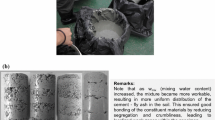Abstract
The marine clay is generally regarded as poor materials for urban applications because of its high settlement and instability. In this study, the soft marine clay is mixing with cementitious material such as cement and lime in different ratios, so that the geotechnical characteristics of blends improved. A series of laboratory experiments are conducted to verify the enhanced performance of treated marine clay. The optimum moisture content (OMC) along with maximum dry unit weight obtained from Standard Proctor compaction test and Harvard miniature test. Unconsolidated undrained test (UUT) and unconfined compression test (UCT) are implemented to find out the compressive strength of samples. Blends selected from the dry side of the compaction curve own larger compressive strength than the others, which means an appropriate amount of water is enough for blends mixing. The results of laboratory tests are utilized to establish neural network models to predict engineering properties such as, compressive strength, optimum moisture content, and maximum dry density of treated marine clay. The correlation between the additive contents as well as curing days and compressive strength has been approved according to the test results. The properties such as maximum dry density, water contents, and additive contents are used as inputs to predict the compressive strengths. The predicted consequences of neural networks are well fitted with laboratory test results.
Access this chapter
Tax calculation will be finalised at checkout
Purchases are for personal use only
Similar content being viewed by others
References
Ampera, B., Aydogmust, T.: Recent experiences with cement and lime-stabilization of local typical poor cohesive soil. Geotechnik-kolloquium Freiberg (2005)
ASTM-D2166: Standard Test Method for Unconfined Compressive Strength of Cohesive Soil. ASTM International, West Conshohocken (2013)
ASTM-D2850: Standard Test Method for Unconsolidated-Undrained Triaxial Compression Test on Cohesive Soils. ASTM International, West Conshohocken (2007)
ASTM-D698: Standard Test Methods for Laboratory Compaction. ASTM International, West Conshohocken (2007)
Cordova, F.J.: Field application of the pocket penetrometer. Am. Soc. Testing Mater. Spec. Tech. Publ. 232, 372–375 (1957)
CWC: Glass Feedstock Evaluation Project, Testing Program Design. Clean Washington Center, Dames and Moore Inc., West Conshohocken (1993)
Günaydın, O.: Estimation of soil compaction parameters by using statistical analyses and artificial neural networks. Environ. Geol. 57, 203–215 (2009)
Heikki, K.: Stabilization of clay with inorganic by-products. J. Mater. Civ. Eng. 12(4), 307–309 (2000)
Jacques, L., Marc-Andre, B., Marc, C.: Laboratory investigation on the lime stabilization of sensitive clays shear strength development. Can. Geotech. J. 27, 294–304 (1990)
Karim, N.A.A., Rashid, A.S.A., Noor, N.M., Yaacob, H.: Effect of cement stabilized kaolin subgrade on strength properties. J. Appl. Sci. 14(8), 842–845 (2014)
Monowar Hussain, S.K.: The influence of lime on the compaction behaviour of soils. J. Environ. Geotech. (2015)
Nguyen, L., Fatahi, B., Khabbaz, H.: Development of a constitutive model to predict the behavior of cement-treated clay during cementation degradation: C3 model. Int. J. Geomech. 17(7) (2017)
Sarika, S.D., Deepankar, C., Salunkhe, J.S.: Ground improvement of marine clay for highway construction. In: IFCEE 2015 and ASCE 2015, Mumbai, India (2015)
Scavuzzo, R.: Use of the Harvard miniature apparatus for obtaining moisture unit weight relationships of soils (1984)
Singh, H.P., Bailer-Jones, C.A.L., Gupta, R.: An introduction to artificial neural networks. Autom. Data Anal. Astron. I, 51–68 (2001)
So, T.C., Lee, M.K., Hui, T., Shiu, Y.K.: Study of using recycled glass cullet as an engineering fill in reclamation and earthworks in Hong Kong. The Government of the Hong Kong Special Administrative Region (2014)
Sunny, S., Vogel, N., Howell, C., Vu, T.L., Aizenberg, J.: Lubricant-infused nanoparticulate coatings assembled by layer-by layer deposition. Adv. Funct. Mater. 24, 6658–6667 (2014)
Venkateswarlu, D., Anjan-kumar, M., Prasada-raju, G.V.R.: A study on the lime – cement stabilized marine clay. J. Microbiol. Biotech. Environ Sci. 16(2), 439–444 (2014)
Wu, D.Q., Xu, W.Y., Tjuar, R.: Improvements of marine clay slurries using chemical-physical combined method (CPCM). J. Rock Mech. Geotech. Eng. 7, 220–225 (2015)
Author information
Authors and Affiliations
Corresponding author
Editor information
Editors and Affiliations
Rights and permissions
Copyright information
© 2021 The Author(s), under exclusive license to Springer Nature Switzerland AG
About this paper
Cite this paper
Wang, Y., Yan, W., Ieong, J., Lok, T.M.H. (2021). Laboratory Evaluation and Neural Network Modeling of Treated Macau Marine Clay. In: Fatahi, B., Chen, SE., Hu, J. (eds) Resilient Design and Construction of Geostructures Against Natural Hazards. GeoChina 2021. Sustainable Civil Infrastructures. Springer, Cham. https://doi.org/10.1007/978-3-030-79854-3_1
Download citation
DOI: https://doi.org/10.1007/978-3-030-79854-3_1
Published:
Publisher Name: Springer, Cham
Print ISBN: 978-3-030-79853-6
Online ISBN: 978-3-030-79854-3
eBook Packages: Earth and Environmental ScienceEarth and Environmental Science (R0)




